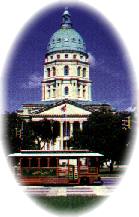
On August 11, 1925, E.H. Crosby of the Crosby Brothers Company made the first announcement of his plans to provide the capital city of Kansas with a modern theatre. The Jayhawk Theatre opened its doors on August, 1926.
Placed on the national register of historic places in 1974, Topeka architect Thomas W. Williamson was the designer for the entire complex. It was later revealed that Mr. Williamson was the architect of record, and that the Boller Brothers, noted theatre designers from Kansas City, were actually responsible for the design of the theatre. These two brothers used the Jayhawk Theatre as a prototype for more than 300 theatres they designed in their career. Elements such as the air conditioning and its steel and concrete structure made the Jayhawk Theatre unique and a forerunner of its day.
In 1926, the theatre could seat an audience of 1500 people. A balcony capable of 650 seats faces the stage, with every person in the theatre having "the best seat in the house." The Boller Brothers? unique design incorporated steel trusswork and eliminated supporting columns in the auditorium, thereby allowing every seat to be a great one. Serving primarily as a movie theatre, vaudeville acts also played on the Jayhawk?s stage. Radio station WIBW first broadcast from the stage in 1927.
In 1929, 14 year old Gypsy Rose Lee?s career was launched on the Jayhawk?s stage. Her sister eloped running off from the act minutes before they were to perform. Gypsy took her place center stage and a star was born.
In May of 1976, the curtain closed on the Jayhawk Theatre for the last time, after half a century of motion picture and stage entertainment. The Hotel Jayhawk, also closed shortly after the theatre, was renovated into the Jayhawk Tower office complex in 1982 and the theatre became cordoned off. Kansas State Historical Society preservation officer Dr. Ramon Powers wrote a letter in 1992 stating, "that demolition of the building would damage the historic character of the Jayhawk and two adjacent buildings on the register: the Jayhawk Tower and the Davis Building."
City officials deterred demolition requests during 1992 and also declined offers to acquire the theatre. Concerned citizens stepped forward in January, 1993 with proposals to save the Jayhawk. Through those efforts, the Historic Jayhawk Theatre, Inc. was formed as a 501C3 charitable corporation and the theatre seemed destined for rebirth.
In 1993, the Kansas State Legislature designated the Jayhawk as the official State Theatre of Kansas.
The volunteer Board of Directors of The Jayhawk adopted a mission statement and goals to help guide through the restoration and operation. When re-opened, The Jayhawk will "provide a multi-purpose community theater which will enhance the cultural arts, business and education of the citizens of Kansas. The Jayhawk State Theatre of Kansas will celebrate Topeka's rich entertainment past and enhance downtown Topeka and provide a venue for cultural arts, business and education activities."